Tolerance of Tall Fescue (Festuca arundinacea Schreb.) Growing in Extensive Green Roof Systems to Saline Water Irrigation with Varying Leaching Fractions
Abstract
:1. Introduction
2. Materials and Methods
2.1. Experimental Setup
2.2. Turfgrass Establishment
2.3. Greenhouse Climate Conditions
2.4. Turfgrass Maintenance and Irrigation Regimes
2.5. Measurements
2.6. Experimental Design and Statistics
3. Results and Discussion
3.1. Leachate Electrical Conductivity
3.2. Green Turf Cover
3.3. Cumulative Clipping Dry Weight
3.4. Response of Green Turf Cover to Leachate Electrical Conductivity
4. Conclusions
Author Contributions
Funding
Data Availability Statement
Acknowledgments
Conflicts of Interest
References
- Su, S.; Tian, J.; Dong, X.; Tian, Q.; Wang, N.; Xi, Y. An Impervious Surface Spectral Index on Multispectral Imagery Using Visible and Near-Infrared Bands. Remote Sens. 2022, 14, 3391. [Google Scholar] [CrossRef]
- Santamouris, M. Cooling the Cities: A Review of Reflective and Green Roof Mitigation Technologies to Fight Heat Island and Improve Comfort in Urban Environments. Sol. Energy 2014, 103, 682–703. [Google Scholar] [CrossRef]
- Zheng, X.; Zou, Y.; Lounsbury, A.W.; Wang, C.; Wang, R. Green Roofs for Stormwater Runoff Retention: A Global Quantitative Synthesis of the Performance. Resour. Conserv. Recycl. 2021, 170, 105577. [Google Scholar] [CrossRef]
- Bevilacqua, P. The Effectiveness of Green Roofs in Reducing Building Energy Consumption Across Different Climates: A Summary of Literature Results. Renew. Sust. Energ. Rev. 2021, 151, 111523. [Google Scholar] [CrossRef]
- Wang, X.; Li, H.; Sodoudi, S. The Effectiveness of Cool and Green Roofs in Mitigating Urban Heat Island and Improving Human Thermal Comfort. Build. Environ. 2022, 217, 109082. [Google Scholar] [CrossRef]
- Berndtsson, J.C. Green Roof Performance Towards Management of Runoff Water Quantity and Quality: A Review. Ecol. Eng. 2010, 36, 351–360. [Google Scholar] [CrossRef]
- Fernandez-Cañero, R.; Emilsson, T.; Fernandez-Barba, C.; Machuca, M.Á.H. Green Roof Systems: A Study of Public Attitudes and Preferences in Southern Spain. J. Environ. Manag. 2013, 128, 106–115. [Google Scholar] [CrossRef]
- Dunnett, N.; Nagase, A.; Hallam, A. The Dynamics of Planted and Colonising Species on a Green Roof over Six Growing Seasons 2001–2006: Influence of Substrate Depth. Urban Ecosyst. 2008, 11, 373–384. [Google Scholar] [CrossRef]
- Papafotiou, M.; Pergialioti, N.; Tassoula, L.; Massas, I.; Kargas, G. Growth of Native Aromatic Xerophytes in an Extensive Mediterranean Green Roof as Affected by Substrate Type and Depth and Irrigation Frequency. HortScience 2013, 48, 1327–1333. [Google Scholar] [CrossRef]
- Getter, K.L.; Rowe, D.B. Substrate Depth Influences Sedum Plant Community on a Green Roof. HortScience 2009, 44, 401–407. [Google Scholar] [CrossRef]
- Beard, J.B.; Green, R.L. The Role of Turfgrasses in Environmental Protection and Their Benefits to Humans. J. Environ. Qual. 1994, 23, 452–460. [Google Scholar] [CrossRef]
- Nektarios, P.A.; Ntoulas, N.; Kotopoulis, G.; Ttoulou, T.; Ilia, P. Festuca arundinacea Drought Tolerance and Evapotranspiration when Grown on Two Extensive Green Roof Substrate Depths and Under Two Irrigation Regimes. Eur. J. Hortic. Sci. 2014, 79, 142–149. [Google Scholar]
- Ntoulas, N.; Nektarios, P.A.; Kotopoulis, G.; Ilia, P.; Ttooulou, T. Quality Assessment of Three Warm-Season Turfgrasses Growing in Different Substrate Depths on Shallow Green Roof Systems. Urban For. Urban Green. 2017, 26, 163–168. [Google Scholar] [CrossRef]
- Ntoulas, N.; Nektarios, P.A.; Charalambous, E.; Psaroulis, A. Zoysia matrella Cover Rate and Drought Tolerance in Adaptive Extensive Green Roof Systems. Urban For. Urban Green. 2013, 12, 522–531. [Google Scholar] [CrossRef]
- Ntoulas, N.; Nektarios, P.A. Paspalum vaginatum NDVI When Grown on Shallow Green Roof Systems and Under Moisture Deficit Conditions. Crop Sci. 2017, 57, S-147–S-160. [Google Scholar] [CrossRef]
- Ntoulas, N.; Nektarios, P.A. Paspalum vaginatum Drought Tolerance and Recovery in Adaptive Extensive Green Roof Systems. Ecol. Eng. 2015, 82, 189–200. [Google Scholar] [CrossRef]
- Agra, H.; Solodar, A.; Bawab, O.; Levy, S.; Kadas, G.J.; Blaustein, L.; Greenbaum, N. Comparing Greywater versus Tap Water and Coal Ash versus Perlite on Growth of Two Plant Species on Green Roofs. Sci. Total Environ. 2018, 633, 1272–1279. [Google Scholar] [CrossRef]
- Orsini, F.; Accorsi, M.; Luz, P.; Tsirogiannis, I.L.; Gianquinto, G. Sustainable Water Management in Green Roofs. In Sustainable Water Management in Urban Environments. The Handbook of Environmental Chemistry; Younos, T., Parece, T., Eds.; Springer: Cham, Switzerland, 2016; Volume 47. [Google Scholar] [CrossRef]
- Stratigea, D.; Makropoulos, C. Balancing Water Demand Reduction and Rainfall Runoff Minimisation: Modelling Green Roofs, Rainwater Harvesting, and Greywater Reuse Systems. Water Sci. Technol. Water Supply 2015, 15, 248–255. [Google Scholar] [CrossRef]
- Ntoulas, N.; Varsamos, I. Performance of Two Seashore Paspalum (Paspalum vaginatum Sw.) Varieties Growing in Shallow Green Roof Substrate Depths and Irrigated with Seawater. Agronomy 2021, 11, 250. [Google Scholar] [CrossRef]
- Paraskevopoulou, A.T.; Ntoulas, N.; Bourtsoukli, D.; Bertsouklis, K. Effect of Seawater Irrigation on Arthrocnemum macrostachyum Growing in Extensive Green Roof Systems under Semi-Arid Mediterranean Climatic Conditions. Agronomy 2023, 13, 1198. [Google Scholar] [CrossRef]
- Carrow, R.N.; Duncan, R.R.; Huck, M.T. Turfgrass and Landscape Irrigation Water Quality: Assessment and Management, 1st ed.; CRC Press: Boca Raton, FL, USA, 2009. [Google Scholar]
- Serena, M.; Leinauer, B.; Sallenave, R.; Schiavon, M.; Maier, B. Turfgrass Establishment from Polymer-Coated Seed Under Saline Irrigation. HortScience 2012, 47, 1789–1794. [Google Scholar] [CrossRef]
- Schaan, C.M.; Devitt, D.; Morris, R.; Clark, L. Cyclic Irrigation of Turfgrass Using a Shallow Saline Aquifer. Agron. J. 2003, 95, 660–667. [Google Scholar] [CrossRef]
- Sevostianova, E.; Leinauer, B.; Sallenave, R.; Karcher, D.; Maier, B. Soil Salinity and Quality of Sprinkler and Drip Irrigated Warm-Season Turfgrasses. Agron. J. 2011, 103, 1773–1784. [Google Scholar] [CrossRef]
- Ampim, P.A.; Sloan, J.J.; Cabrera, R.I.; Harp, D.A.; Jaber, F.H. Green Roof Growing Substrates: Types, Ingredients, Composition and Properties. J. Environ. Hortic. 2010, 28, 244–252. [Google Scholar] [CrossRef]
- Carrow, R.R.; Huck, M.T.; Duncan, R.R. Leaching for Salinity Management on Turfgrass Sites. USGA Green Sect. Rec. 2000, 38, 15–24. [Google Scholar]
- Duncan, R.R.; Carrow, R.N.; Huck, M.T. Effective use of seawater irrigation on turfgrass. USGA Green Sect. Rec. 2000, 38, 11–17. [Google Scholar]
- Liu, H.; Todd, J.L.; Luo, H. Turfgrass Salinity Stress and Tolerance—A Review. Plants 2023, 12, 925. [Google Scholar] [CrossRef] [PubMed]
- Marcum, K.B. Use of Saline and Non-Potable Water in the Turfgrass Industry: Constraints and Developments. Agric. Water Manage. 2006, 80, 132–146. [Google Scholar] [CrossRef]
- Schiavon, M.; Macolino, S.; Pornaro, C. Response of Twenty Tall Fescue (Schedonorus arundinaceus (Schreb.) Dumort.) Cultivars to Low Mowing Height. Agronomy 2021, 11, 943. [Google Scholar] [CrossRef]
- Uddin, M.K.; Juraimi, A.S. Salinity Tolerance Turfgrass: History and Prospects. Sci. World J. 2013, 2013, 409413. [Google Scholar] [CrossRef]
- Harivandi, M.A.; Butler, J.D.; Wu, L. Salinity and turfgrass culture. In Turfgrass; Waddington, D.V., Carrow, R.N., Shearman, R.C., Eds.; Series No. 32; American Society of Agronomy: Madison, WI, USA, 1992; pp. 207–229. [Google Scholar] [CrossRef]
- Wu, L.; Huang, Z.Z.; Burau, R.G. Selenium Accumulation and Selenium-Salt Cotolerance in Five Grass Species. Crop Sci. 1988, 28, 517–522. [Google Scholar] [CrossRef]
- Richardson, M.; Karcher, D.; Purcell, L. Quantifying Turfgrass Cover Using Digital Image Analysis. Crop Sci. 2001, 41, 1884–1888. [Google Scholar] [CrossRef]
- Motulsky, H.J.; Christopoulos, A. Fitting Models to Biological Data Using Linear and Nonlinear Regression: A Practical Guide to Curve Fitting; GraphPad Software Inc.: San Diego, CA, USA, 2003. [Google Scholar]
- Miyamoto, S.; Glenn, E.P.; Olsen, M.W. Growth, Water Use and Salt Uptake of Four Halophytes Irrigated with Highly Saline Water. J. Arid Environ. 1996, 32, 141–159. [Google Scholar] [CrossRef]
- Uddin, M.K.; Juraimi, A.S.; Ismail, M.R.; Othman, R.; Rahim, A.A. Relative Salinity Tolerance of Warm Season Turfgrass Species. J. Environ. Biol. 2011, 32, 309–312. [Google Scholar]
- Lee, G.; Carrow, R.N.; Duncan, R.R. Criteria for Assessing Salinity Tolerance of the Halophytic Turfgrass Seashore Paspalum. Crop Sci. 2005, 45, 251–258. [Google Scholar] [CrossRef]
- Qian, Y.L.; Wilhelm, S.J.; Marcum, K.B. Comparative Responses of Two Kentucky Bluegrass Cultivars to Salinity Stress. Crop Sci. 2001, 41, 1895–1900. [Google Scholar] [CrossRef]
- Lunt, O.R.; Youngner, V.B.; Oertli, J.J. Salinity Tolerance of Five Turfgrass Varieties. Agron. J. 1961, 53, 247–249. [Google Scholar] [CrossRef]
- Alshammary, S.F.; Qian, Y.L.; Wallner, S.J. Growth Response of Four Turfgrass Species to Salinity. Agric. Water Manag. 2004, 66, 97–111. [Google Scholar] [CrossRef]
- Uddin, M.K.; Juraimi, A.S.; Ismail, M.; Hossain, M.A.; Othman, R.; Abdul Rahim, A. Physiological and Growth Responses of Six Turfgrass Species Relative to Salinity Tolerance. Sci. World J. 2012, 2012, 905468. [Google Scholar] [CrossRef]
- Noaman, M.N.; El-Haddad, E.S. Effects of Irrigation Water Salinity and Leaching Fraction on the Growth of Six Halophyte Species. J. Agric. Sci. 2000, 135, 279–285. [Google Scholar] [CrossRef]
- Karimi, I.Y.M.; Kurup, S.S.; Salem, M.A.M.A.; Cheruth, A.J.; Purayil, F.T.; Subramaniam, S.; Pessarakli, M. Evaluation of Bermuda and Paspalum Grass Types for Urban Landscapes under Saline Water Irrigation. J. Plant Nutr. 2018, 41, 888–902. [Google Scholar] [CrossRef]
- Manuchehri, R.; Salehi, H. Morphophysiological and Biochemical Changes in Tall Fescue (Festuca arundinacea Schreb.) under Combined Salinity and Deficit Irrigation Stresses. Desert 2015, 20, 29–38. [Google Scholar]
- Zhang, Q.; Zuk, A.; Rue, K. Salinity Tolerance of Nine Fine Fescue Cultivars Compared to Other Cool-Season Turfgrasses. Sci. Hortic. 2013, 159, 67–71. [Google Scholar] [CrossRef]
- Leskys, A.M.; Devitt, D.A.; Verchick, L.S.; Morris, R.L. Response of Tall Fescue to Saline Water as Influenced by Leaching Fractions and Irrigation Uniformity Distributions. Agronomy 1999, 91, 409–416. [Google Scholar] [CrossRef]
- Maas, E.V.; Hoffman, G.J. Crop salt tolerance—Current assessment. J. Irrig. Drain. Div. 1977, 103, 115–134. [Google Scholar] [CrossRef]
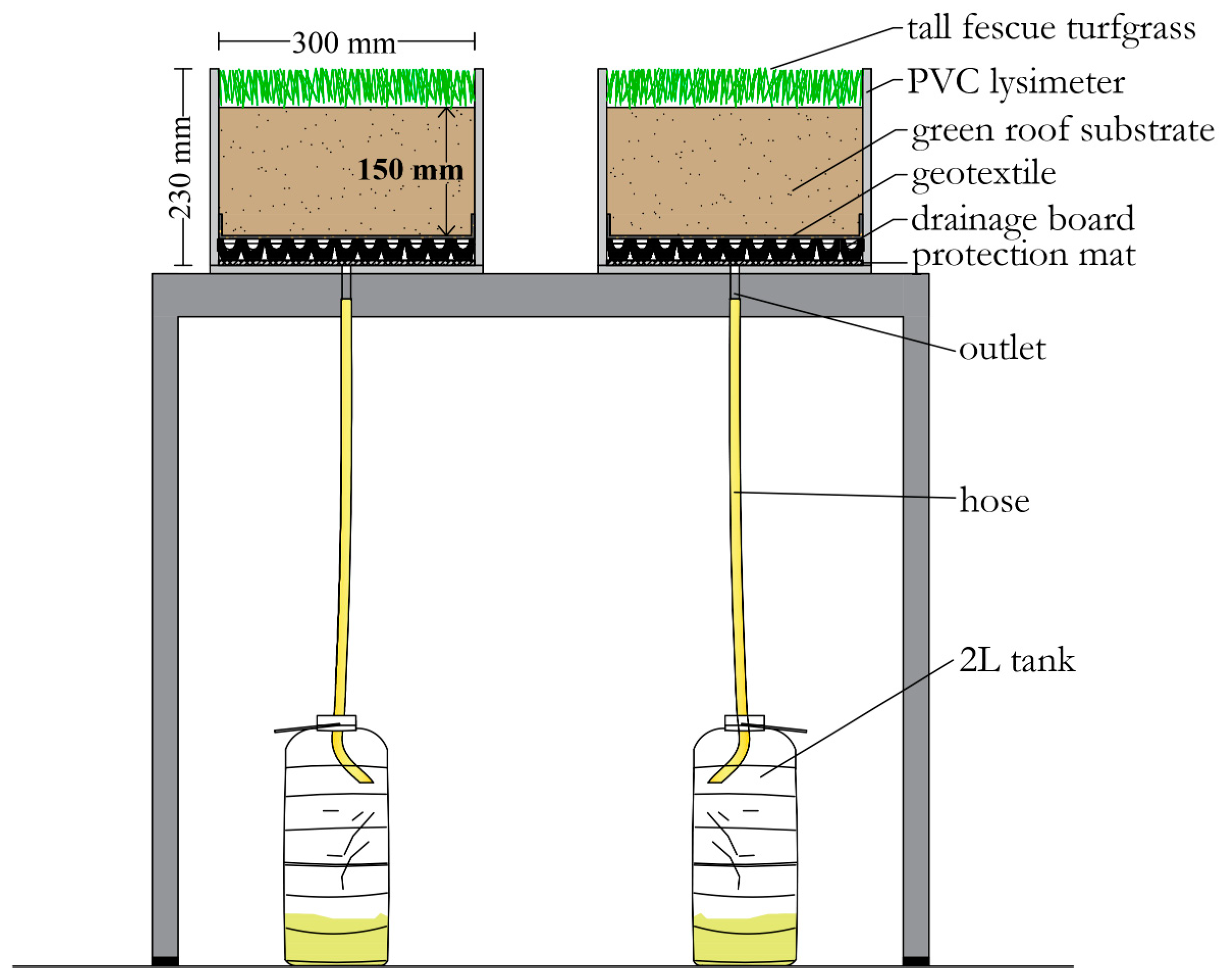
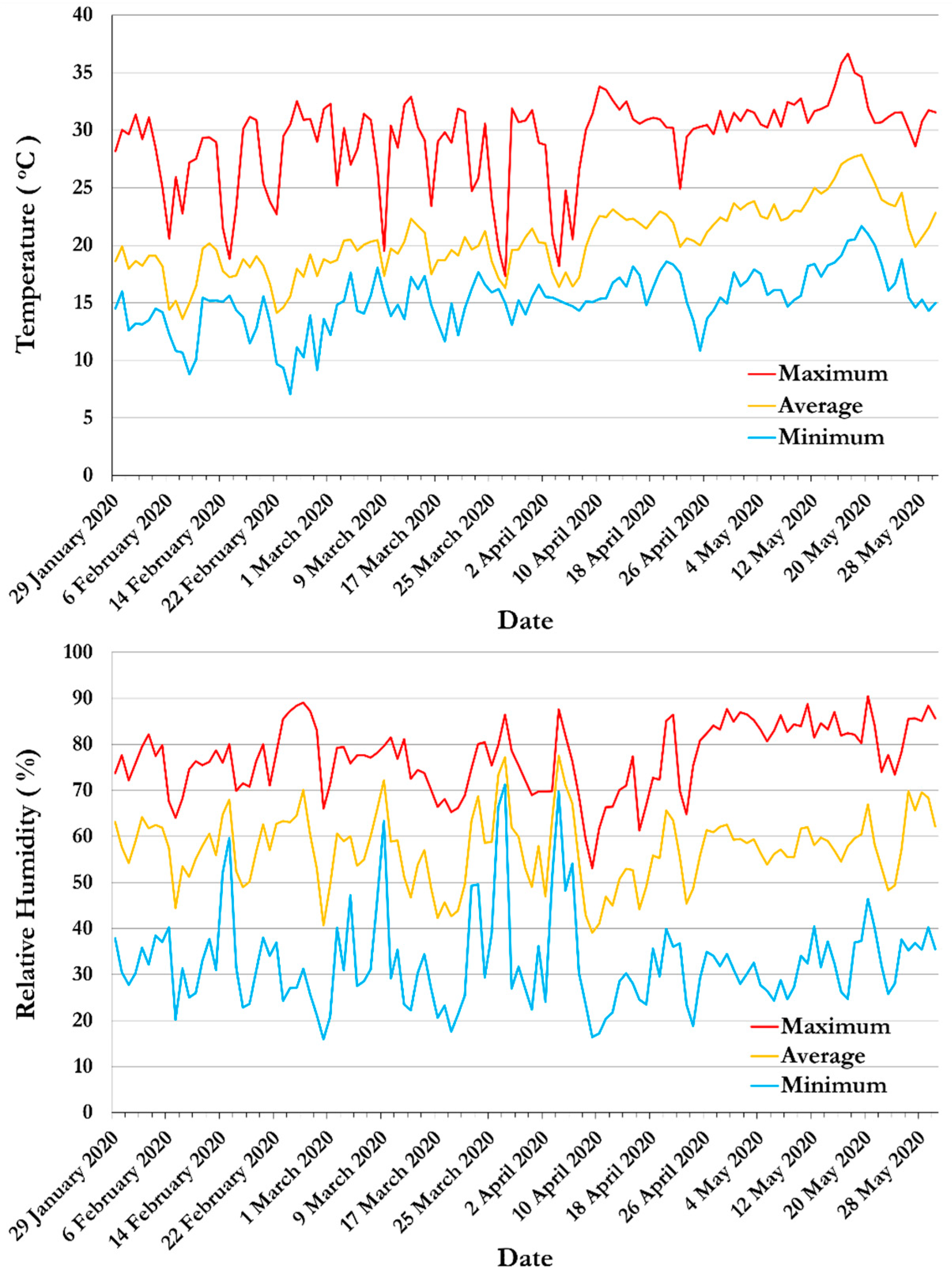
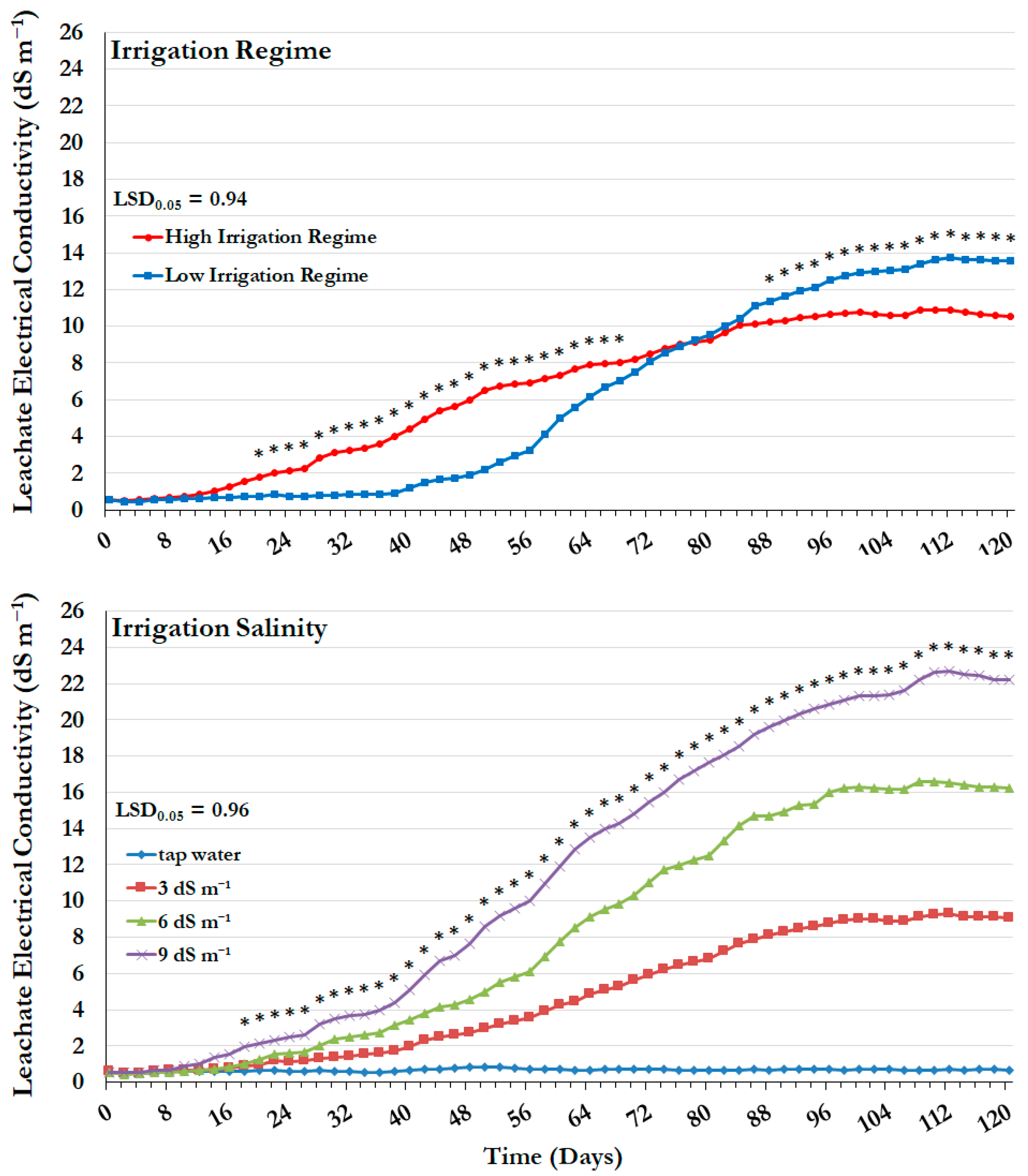
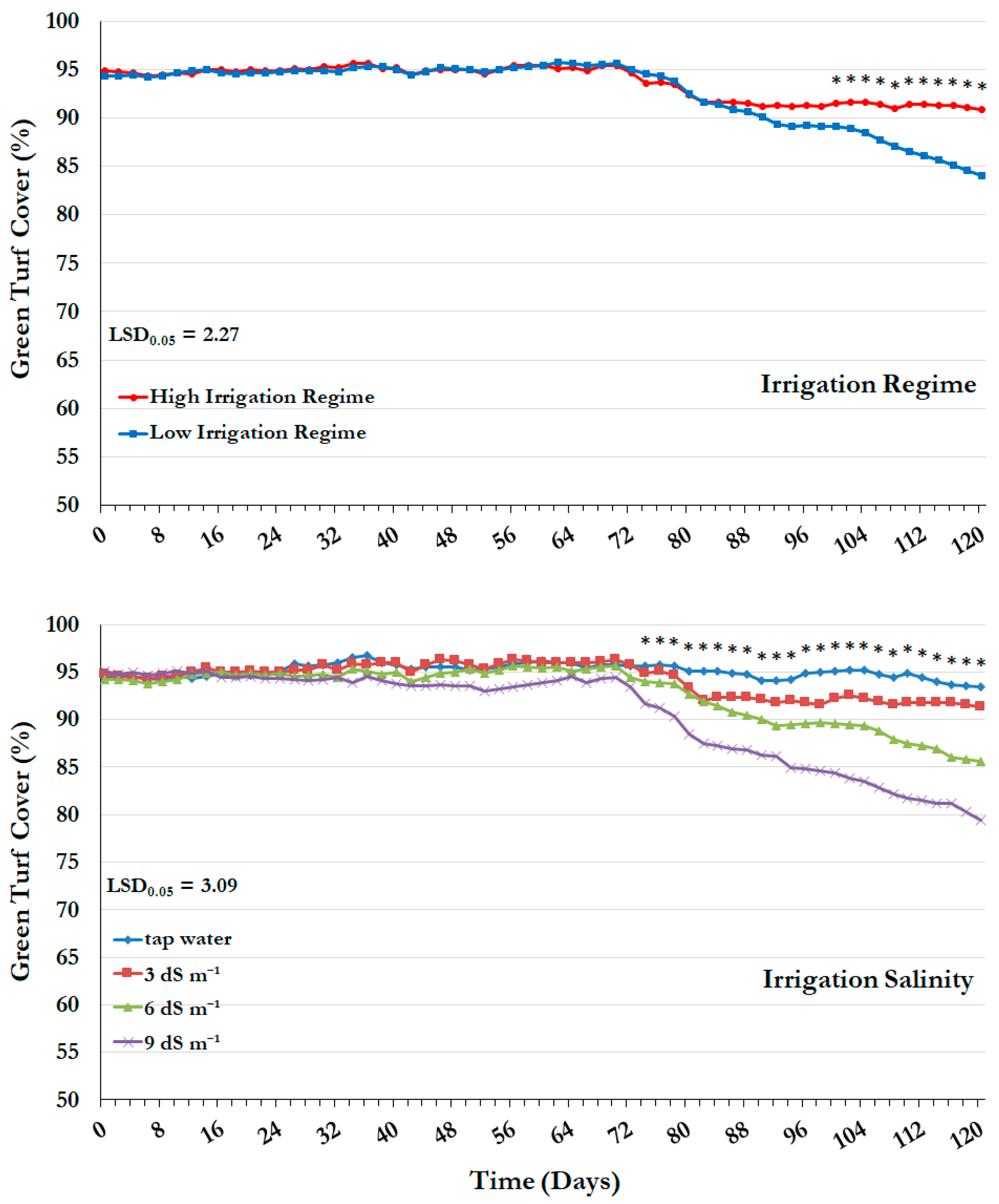
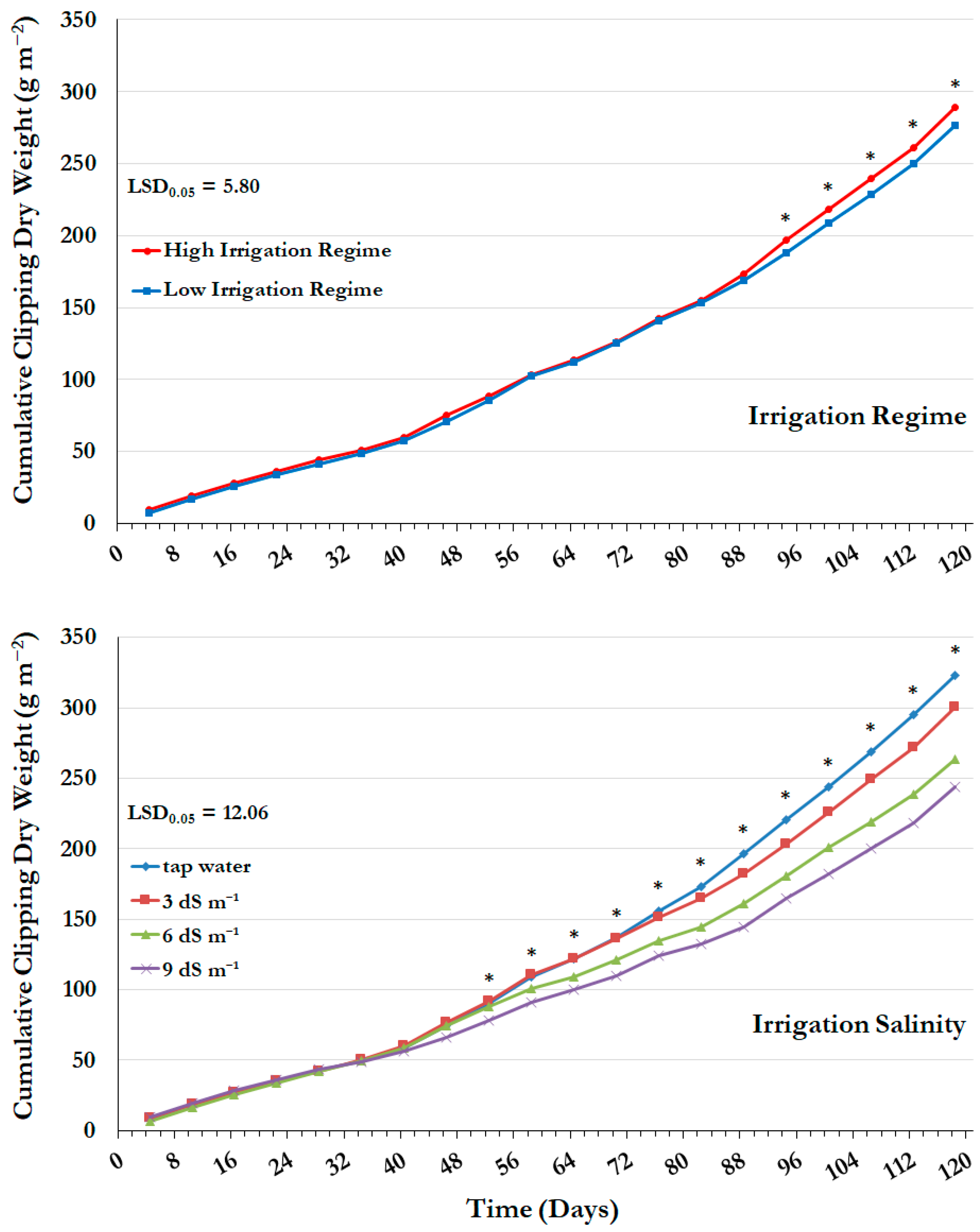
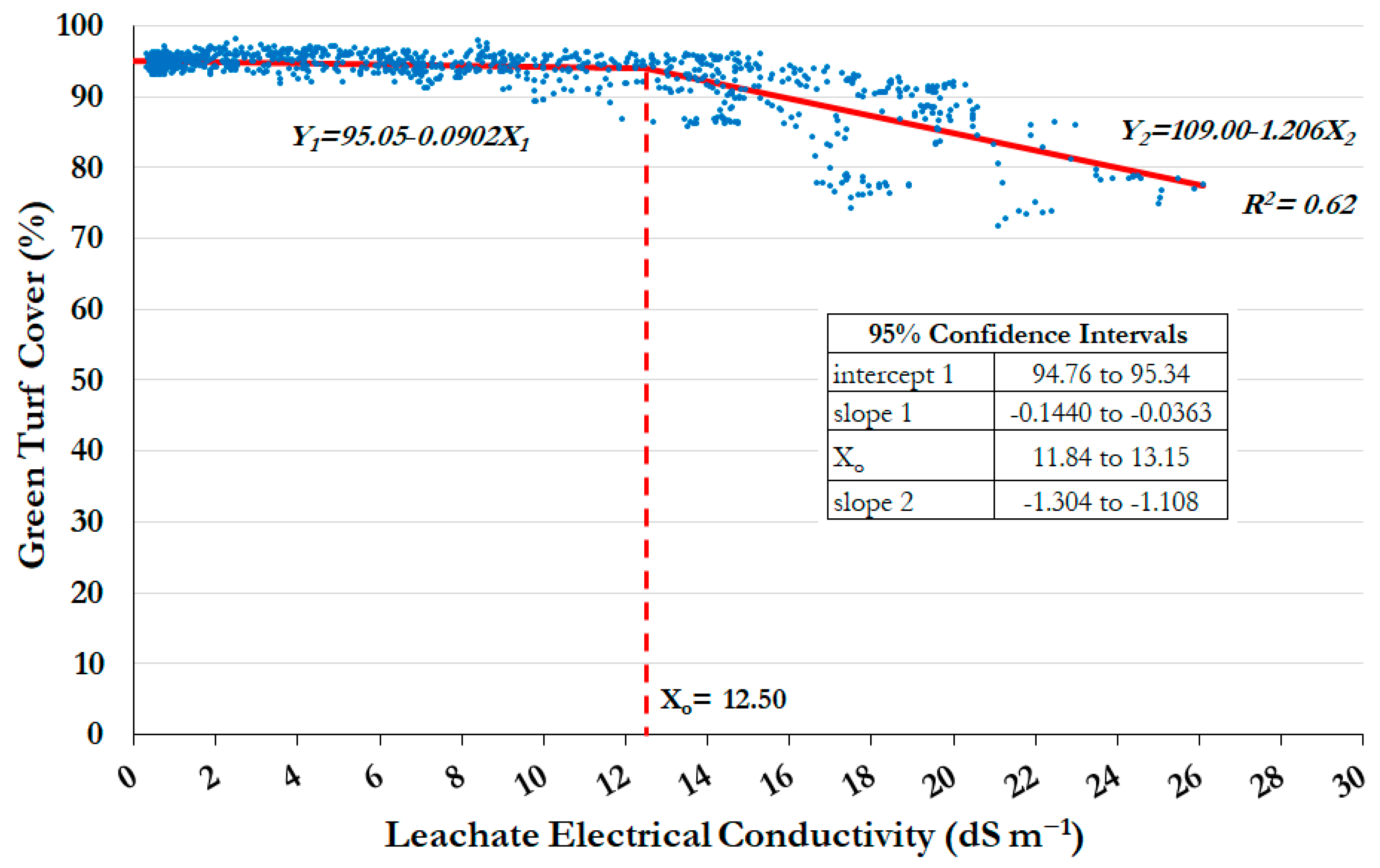
| Parameter | Units Measured | Value |
|---|---|---|
| pH (CaCl2) | 7.2 | |
| Electrical conductivity (water, 1:10, m:v), | dS m–1 | 0.60 |
| Dry bulk density | kg L–1 | 0.80 |
| Bulk density at maximum water-holding capacity | kg L–1 | 1.20 |
| Total pore volume | % | 63.8 |
| Maximum water-holding capacity | % (v/v) | 54.2 |
| Hydraulic conductivity | mm min–1 | 7.62 |
| Organic matter content | % (w/w) | 10.5 |
| Phosphorus, P2O5 (CAL) | mg L−1 | 112.6 |
| Potassium, K2O (CAL) | mg L−1 | 578.6 |
| Magnesium, Mg (CaCl2) | mg L−1 | 289.3 |
| Nitrate + ammonium (CaCl2) | mg L−1 | 10.4 |
| Particle size analysis: | ||
| 9.5–6.3 mm | % (w/w) | 1.9 |
| 6.3–3.2 mm | % (w/w) | 23.6 |
| 3.2–2.0 mm | % (w/w) | 17.3 |
| 2.0–1.0 mm | % (w/w) | 25.9 |
| 1.0–0.25 mm | % (w/w) | 20.4 |
| 0.25–0.05 mm | % (w/w) | 4.4 |
| 0.05–0.002 mm | % (w/w) | 5.4 |
| <0.002 mm | % (w/w) | 1.1 |
| Source of Variation | Leachate Electrical Conductivity (dS m−1) | Green Turf Cover (%) | Cumulative Clipping Dry Weight (g m−2) |
|---|---|---|---|
| Irrigation regime (I) | NS | NS | * |
| Irrigation salinity (S) | *** | *** | *** |
| I × S | NS | NS | NS |
| Sampling date (T) | *** | *** | *** |
| I × T | *** | *** | * |
| S × T | *** | *** | *** |
| I × S × T | *** | NS | NS |
| Treatment means | |||
| Irrigation regime | |||
| High | 6.45 a | 93.71 a | 121.42 a |
| Low | 5.98 a | 92.69 a | 117.13 b |
| LSD | 0.80 | 1.61 | 2.25 |
| Irrigation salinity | |||
| Tap water | 0.66 d | 95.10 a | 132.38 a |
| 3 dS m−1 | 4.60 c | 94.26 ab | 126.46 a |
| 6 dS m−1 | 8.17 b | 92.81 b | 113.42 b |
| 9 dS m−1 | 11.42 a | 90.63 c | 104.83 b |
| LSD | 0.40 | 1.79 | 9.25 |
Disclaimer/Publisher’s Note: The statements, opinions and data contained in all publications are solely those of the individual author(s) and contributor(s) and not of MDPI and/or the editor(s). MDPI and/or the editor(s) disclaim responsibility for any injury to people or property resulting from any ideas, methods, instructions or products referred to in the content. |
© 2024 by the authors. Licensee MDPI, Basel, Switzerland. This article is an open access article distributed under the terms and conditions of the Creative Commons Attribution (CC BY) license (https://creativecommons.org/licenses/by/4.0/).
Share and Cite
Ntoulas, N.; Papaioannou, G.; Bertsouklis, K.; Nektarios, P.A. Tolerance of Tall Fescue (Festuca arundinacea Schreb.) Growing in Extensive Green Roof Systems to Saline Water Irrigation with Varying Leaching Fractions. Land 2024, 13, 167. https://doi.org/10.3390/land13020167
Ntoulas N, Papaioannou G, Bertsouklis K, Nektarios PA. Tolerance of Tall Fescue (Festuca arundinacea Schreb.) Growing in Extensive Green Roof Systems to Saline Water Irrigation with Varying Leaching Fractions. Land. 2024; 13(2):167. https://doi.org/10.3390/land13020167
Chicago/Turabian StyleNtoulas, Nikolaos, Georgios Papaioannou, Konstantinos Bertsouklis, and Panayiotis A. Nektarios. 2024. "Tolerance of Tall Fescue (Festuca arundinacea Schreb.) Growing in Extensive Green Roof Systems to Saline Water Irrigation with Varying Leaching Fractions" Land 13, no. 2: 167. https://doi.org/10.3390/land13020167







